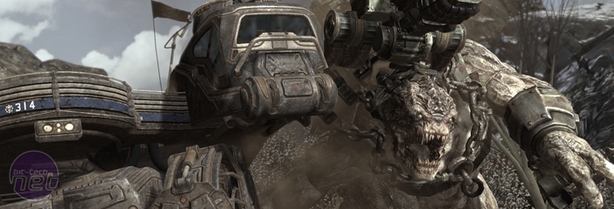
Multiplayer of War
Singleplayer isn’t everything of course, and though running through the streets hunting Locusts is definitely fun on your own for a while, doing it with a friend is certainly a lot more fun.Of course, even better than that is doing it with your worst enemy and stalwartly refusing to revive them, blocking doorways with your body and occasionally blasting brown noise blaring white noise down the microphone at them – take that, Kevin!
The multiplayer segments of Gears of War 2 have naturally been expanded too, both in terms of enhancements and actual new additions to the feature set.
The most important bit of news for most people is that they player count has now been upped to make room for ten people across a set of multiplayer modes. The three main ones, dubbed Wingman, Guardian and Submission we unfortunately didn’t get chance to go hands on with, but are all essentially run of the mill.
In brief though, all you need to know is that Submission is basically a capture-the-flag variant, Guardian is a tweaked version of Assassination from the original game and Wingman is the best one of them all, splitting players into teams of two. We had a brief chat with game designer Cliff Bleszinski about the multiplayer modes and he confessed that Wingman was his favourite mode – and we can see why as it looks to combine the strength of multiplayer with the strength of the two-man co-op mode.
Co-op has always been important to Gears of War of course, so it’s no surprise to see that it has returned anew in the sequel. Not only is the singleplayer campaign, which places a renewed emphasis on vehicles and tactical offense, completely playable in co-op but there’s also a new co-op multiplayer mode called Horde.
Horde, like the other multiplayer game modes, isn’t startlingly original but when it comes to multiplayer games that’s definitely a good thing. Too many games try to do something really clever with multiplayer but only end up with something complex and hard to get to grips with. Yes, Kane and Lynch: Dead Men, we’re looking at you.
Horde mode then is pretty straight forwards and is very similar to the Invasion game mode from the older Unreal Tournament games – it’s a team of five players all working together, trying to survive against wave after wave of enemies. If you get killed then you’re out of the match until the current wave is wiped out, at which point everyone revives. If everyone dies, it’s game over.
How appealing you’ll find Horde mode though is going to vary as, unfortunately, the levels we got to play on weren’t perfectly suited to this game mode. While it’s easy to repel enemies in the open on the lower difficulties, the moment you get to the more taxing waves the game quickly becomes frustrating.
Playing with a team of five other game journos, we struggled to get past Wave 10 on the normal difficulty level and were only able to do so in the end by all clustering into one dead end and defending the entrance with everything we had. This type of action can be enormously fun for short periods and the kind of companionship that builds between team-mates in these situations can occasionally be enough to keep the conversation going on a trip to the canapé counter.
Unfortunately, when this is the entire point of the game it can definitely get old quickly. Every match becomes a case of simply running to the one hold point or narrow hallway you want to hold, then concentrating fire until you run out. That tactic works effortlessly until you get to around Wave 15, at which point even the combined fire of all five players struggles to bring down some of the larger melee-focused Locusts who will quickly get in and decimate your team.
Then again, this is kind of the point – the Horde mode is supposed to be fast-paced, difficult and with lots of ‘Hold the line!’ moments. We can’t exactly fault it for that, and certainly not before the game is released, but we can warn you not to get too excited over it.

MSI MPG Velox 100R Chassis Review
October 14 2021 | 15:04











Want to comment? Please log in.